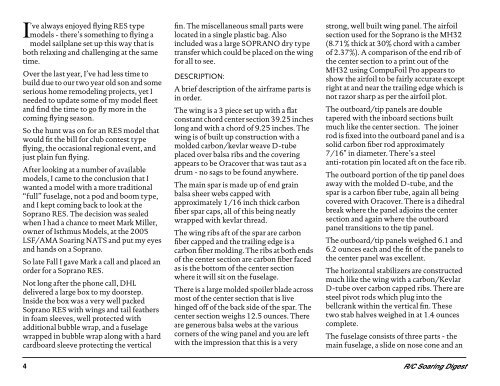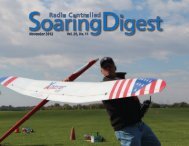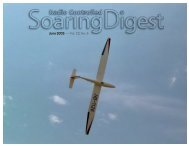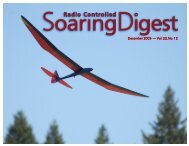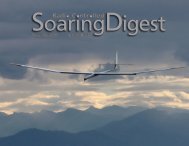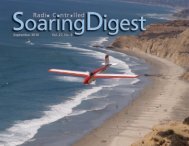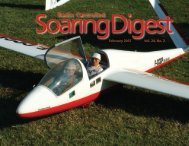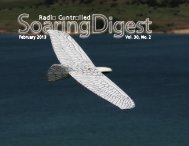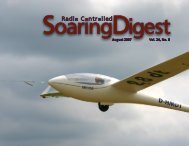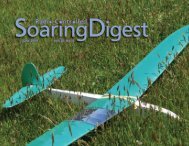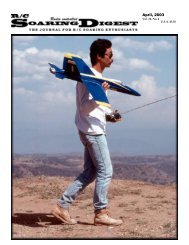August 2006 Vol. 23, No. 8 – R/C - RCSoaring.com
August 2006 Vol. 23, No. 8 – R/C - RCSoaring.com
August 2006 Vol. 23, No. 8 – R/C - RCSoaring.com
Create successful ePaper yourself
Turn your PDF publications into a flip-book with our unique Google optimized e-Paper software.
I<br />
’ve always enjoyed flying RES type<br />
models - there’s something to flying a<br />
model sailplane set up this way that is<br />
both relaxing and challenging at the same<br />
time.<br />
Over the last year, I’ve had less time to<br />
build due to our two year old son and some<br />
serious home remodeling projects, yet I<br />
needed to update some of my model fleet<br />
and find the time to go fly more in the<br />
<strong>com</strong>ing flying season.<br />
So the hunt was on for an RES model that<br />
would fit the bill for club contest type<br />
flying, the occasional regional event, and<br />
just plain fun flying.<br />
After looking at a number of available<br />
models, I came to the conclusion that I<br />
wanted a model with a more traditional<br />
“full” fuselage, not a pod and boom type,<br />
and I kept <strong>com</strong>ing back to look at the<br />
Soprano RES. The decision was sealed<br />
when I had a chance to meet Mark Miller,<br />
owner of Isthmus Models, at the 2005<br />
LSF/AMA Soaring NATS and put my eyes<br />
and hands on a Soprano.<br />
So late Fall I gave Mark a call and placed an<br />
order for a Soprano RES.<br />
<strong>No</strong>t long after the phone call, DHL<br />
delivered a large box to my doorstep.<br />
Inside the box was a very well packed<br />
Soprano RES with wings and tail feathers<br />
in foam sleeves, well protected with<br />
additional bubble wrap, and a fuselage<br />
wrapped in bubble wrap along with a hard<br />
cardboard sleeve protecting the vertical<br />
fin. The miscellaneous small parts were<br />
located in a single plastic bag. Also<br />
included was a large SOPRANO dry type<br />
transfer which could be placed on the wing<br />
for all to see.<br />
DESCRIPTION:<br />
A brief description of the airframe parts is<br />
in order.<br />
The wing is a 3 piece set up with a flat<br />
constant chord center section 39.25 inches<br />
long and with a chord of 9.25 inches. The<br />
wing is of built up construction with a<br />
molded carbon/kevlar weave D-tube<br />
placed over balsa ribs and the covering<br />
appears to be Oracover that was taut as a<br />
drum - no sags to be found anywhere.<br />
The main spar is made up of end grain<br />
balsa sheer webs capped with<br />
approximately 1/16 inch thick carbon<br />
fiber spar caps, all of this being neatly<br />
wrapped with kevlar thread.<br />
The wing ribs aft of the spar are carbon<br />
fiber capped and the trailing edge is a<br />
carbon fiber molding. The ribs at both ends<br />
of the center section are carbon fiber faced<br />
as is the bottom of the center section<br />
where it will sit on the fuselage.<br />
There is a large molded spoiler blade across<br />
most of the center section that is live<br />
hinged off of the back side of the spar. The<br />
center section weighs 12.5 ounces. There<br />
are generous balsa webs at the various<br />
corners of the wing panel and you are left<br />
with the impression that this is a very<br />
strong, well built wing panel. The airfoil<br />
section used for the Soprano is the MH32<br />
(8.71% thick at 30% chord with a camber<br />
of 2.37%). A <strong>com</strong>parison of the end rib of<br />
the center section to a print out of the<br />
MH32 using CompuFoil Pro appears to<br />
show the airfoil to be fairly accurate except<br />
right at and near the trailing edge which is<br />
not razor sharp as per the airfoil plot.<br />
The outboard/tip panels are double<br />
tapered with the inboard sections built<br />
much like the center section. The joiner<br />
rod is fixed into the outboard panel and is a<br />
solid carbon fiber rod approximately<br />
7/16" in diameter. There’s a steel<br />
anti-rotation pin located aft on the face rib.<br />
The outboard portion of the tip panel does<br />
away with the molded D-tube, and the<br />
spar is a carbon fiber tube, again all being<br />
covered with Oracover. There is a dihedral<br />
break where the panel adjoins the center<br />
section and again where the outboard<br />
panel transitions to the tip panel.<br />
The outboard/tip panels weighed 6.1 and<br />
6.2 ounces each and the fit of the panels to<br />
the center panel was excellent.<br />
The horizontal stabilizers are constructed<br />
much like the wing with a carbon/Kevlar<br />
D-tube over carbon capped ribs. There are<br />
steel pivot rods which plug into the<br />
bellcrank within the vertical fin. These<br />
two stab halves weighed in at 1.4 ounces<br />
<strong>com</strong>plete.<br />
The fuselage consists of three parts - the<br />
main fuselage, a slide on nose cone and an<br />
4 R/C Soaring Digest


